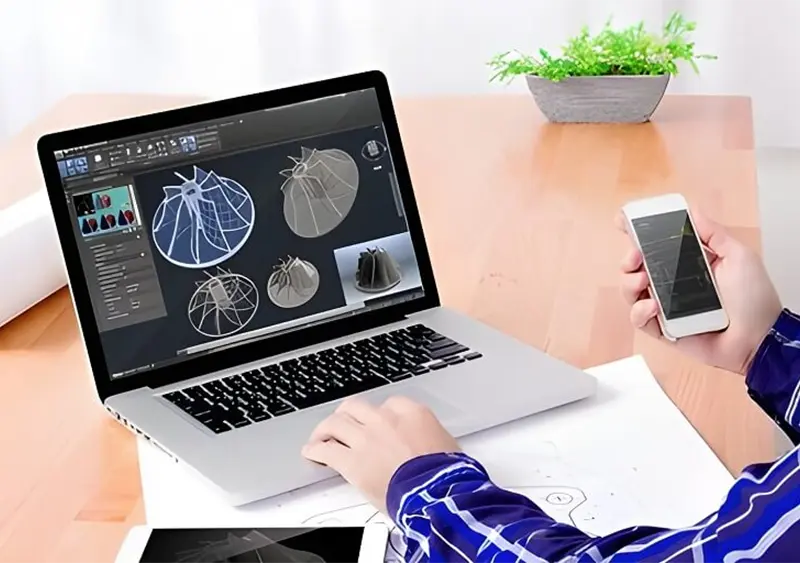Top 3D Rendering Programs for Mac in 2025
"Render fast. Design smart. Stay Apple loyal."

5 MIN READ
July 21, 2025

Written By
Rahimudeen M
But a lot has changed in the last few years. Apple’s M1 and M2 chips are powerful, and more software teams are optimizing for them. If you’re a 3D artist, designer, or animator working on a Mac today, you’ve got more options than ever, and they’re good.
This guide walks you through 3D rendering tools that run well on a Mac. Whether you're creating product shots, animated visuals, architectural scenes, or interactive content, there’s a tool here that fits your workflow.
What are the Best 3D Rendering Programs for Mac Users in 2025
Working with 3D on a Mac wasn’t always smooth. Unsupported GPUs, software that barely kept up, and constant workarounds pushed a lot of artists toward Windows.
But things have shifted. Apple Silicon brought faster chips, better GPU integration, and developers finally started optimizing for macOS. Suddenly, the Mac became a real option for serious 3D work. Check out the best GPUs for 3D rendering in 2025 to get a clearer picture of performance across platforms.
Here’s a rundown of tools that don’t just launch on a Mac. They perform well. Whether you're creating product visuals, animation, or interactive experiences, these programs are built to keep up.
1. Blender – Free, Capable, and Fully Mac-Ready
Blender gives you the full 3D pipeline without charging you anything. You can model, animate, sculpt, and render all in one place. It even has a built-in video editor, which comes in handy for quick post work.
Performance on Mac is solid. On M1 and M2 chips, it runs smoothly and feels responsive. Cycles now supports Metal, and real-time previews in Eevee are quick enough for day-to-day work. For something completely free, Blender does more than most paid tools.
Best for: Artists who want flexibility and control without spending money on software.
2. Cinema 4D – Polished and Made for Mac Creators
Cinema 4D has always had a strong user base among motion designers and visual effects teams. It works particularly well on Mac because Maxon actively supports Apple Silicon, and the interface feels right at home on macOS.
Redshift now works with Metal, which means Mac users can finally use GPU rendering without relying on CUDA. It’s a big win if you're working on visuals that need speed and high-quality output. Cinema 4D also plays nicely with After Effects, so if you're already in the Adobe ecosystem, it slides right into your workflow.
Best suited for: Motion designers, animators, and creative teams working on Macs.
3. Unity – Real-Time 3D That Works on macOS
Most people think of Unity just for games, but honestly, it’s useful for way more than that. You can build interactive demos, product previews, AR & VR walk-throughs without needing to touch Unreal.
It runs pretty smoothly on Apple Silicon, loads quickly, and doesn’t choke on medium-sized scenes. Plus, it supports Metal right out of the box. You don’t need to be a full-on dev to get started either; the interface is clean and easy to figure out.
Best for: Anyone building interactive 3D things for Mac, iOS or web.
4. Unreal Engine 5 – Big Projects, Bigger Visuals
Unreal Engine delivers some of the best real-time graphics available today. With features like Lumen and Nanite, it’s capable of handling highly detailed environments and complex lighting setups. It’s heavier than Unity, but also more visually advanced.
Mac support has improved. While it won’t outperform a Windows machine with RTX, it works well on higher-end M2 systems. For pre-visualization, cinematic shots, or stylized environments, it can still deliver impressive results on macOS.
Best for: Film pre-vis, immersive environments, and projects where visuals come first.
5. Modo – Fast Modeling, Simple Workflow
Modo doesn’t try to be everything, and that’s its strength. It offers a clean modeling experience, fast viewport performance, and enough rendering features to cover most design needs. Since it uses CPU rendering, it sidesteps GPU compatibility issues altogether.
It’s a good choice if you want a modeling-focused app that doesn’t get in your way. Artists who do concept design or stylized assets often prefer Modo for its speed and simplicity.
Best for: Concept artists and small teams who prioritize modeling over simulation.
6. Rhino + V-Ray – Precision and Visual Quality Together
Rhino is known for accurate modeling, especially when curves and technical shapes matter. It’s used heavily in product design, architecture, and jewelry rendering. The latest version runs well on Apple Silicon, and V-Ray brings photorealistic rendering into the same pipeline.
V-Ray for Mac has improved with Metal support, giving decent rendering speeds even without CUDA. If you need precise modeling and high-end visuals without switching to Windows, this combo works well.
Best for: Designers who care about accuracy and need clean renders for review or manufacturing.
7. KeyShot – Drag, Drop, Render
KeyShot is about speed and simplicity. It runs on CPU, so performance is consistent regardless of GPU type. You can import a model, assign materials, light the scene, and hit render all within minutes.
It’s not built for complex animation or heavy simulations, but it’s perfect for creating quick product visuals and client-ready presentations. The real-time preview is especially useful during fast-paced design reviews.
Best for: Product designers and teams that need clean renders without getting too technical.
Conclusion
3D rendering on Mac has come a long way. What was once seen as a limited platform for serious 3D work is now more than capable, thanks to the performance of Apple Silicon and better native software support. Tools like Blender, Cinema 4D, and Unreal Engine now offer smooth workflows on macOS, and even GPU-based renderers like Redshift and V-Ray are finding their place with Metal optimization.
The key is choosing software that matches your style of work. If you're into product visualization or concept design, a CPU-based renderer like KeyShot might be all you need. For animation, motion graphics, or interactive media, programs like Cinema 4D or Unity will serve you well. And if you're a generalist looking for a full pipeline without a big price tag, Blender is hard to beat.
The Mac is no longer just the designer’s machine for 2D workflows. With the right tools, it’s now a strong, reliable choice for 3D rendering too.
Need Studio-Quality Renders Without Worrying About Software Limits?
At Zealous, we bring your ideas to life with high-end 3D rendering services that look great on any device, no matter what platform you're on. Whether it's product visuals, animations, or architectural walkthroughs, we handle the rendering so you can focus on the creative.
Want visuals that speak for your brand? Let our offshore rendering company take care of the rendering.
About the writer :
Rahimudeen M is the Senior Operations Manager at Zealous Services, with over 17 years of experience in project ... management and client success. He ensures smooth operations across 3D visualization, animation, and modeling projects. A natural leader, Rahimudeen is passionate about building high-performing teams and delivering top-tier results for clients across global markets.
Read MoreFrequently Asked Questions (FAQ)
Can I do professional 3D rendering on a Mac in 2025?
Yes, absolutely. With Apple Silicon and Metal support, tools like Blender, Cinema 4D, Redshift, and even Unreal Engine now run reliably on modern Macs. Performance has improved enough to handle everything from modeling to final renders.
Do I need a Mac with an M1 or M2 chip for 3D rendering?
While Intel-based Macs can still run many programs, Apple Silicon (M1 or M2) offers much better performance for rendering, especially with tools optimized for Metal. If you're doing regular 3D work, an M-series chip is strongly recommended.
Which rendering software runs best on macOS right now?
Blender, Cinema 4D, Unity, and KeyShot all run very well on macOS. Redshift and V-Ray have made big improvements too. The best choice depends on your workflow whether you're focused on animation, product visuals, or real-time experiences.
Is GPU rendering possible on a Mac without NVIDIA?
Yes. While CUDA-based GPU rendering is not supported, many engines like Redshift and Cycles now use Metal to enable GPU acceleration on Macs. You can still get strong render performance without an NVIDIA card.
What is the easiest 3D rendering software for Mac beginners?
KeyShot is ideal for beginners because of its drag-and-drop workflow and real-time preview. Blender is also beginner-friendly once you learn the interface, and it offers much more flexibility if you want to grow into full 3D production
Table Of Contents
What are the Best 3D Rendering Programs for Mac Users in 2025
Blender – Free, Capable, and Fully Mac-Ready
Cinema 4D – Polished and Made for Mac Creators
Unity – Real-Time 3D That Works on macOS
Unreal Engine 5 – Big Projects, Bigger Visuals
Modo – Fast Modeling, Simple Workflow
Rhino + V-Ray – Precision and Visual Quality Together
KeyShot – Drag, Drop, Render
Conclusion